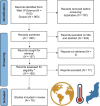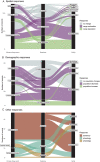Bat responses to climate change: a systematic review
- PMID: 36054527
- PMCID: PMC10087939
- DOI: 10.1111/brv.12893
Bat responses to climate change: a systematic review
Abstract
Understanding how species respond to climate change is key to informing vulnerability assessments and designing effective conservation strategies, yet research efforts on wildlife responses to climate change fail to deliver a representative overview due to inherent biases. Bats are a species-rich, globally distributed group of organisms that are thought to be particularly sensitive to the effects of climate change because of their high surface-to-volume ratios and low reproductive rates. We systematically reviewed the literature on bat responses to climate change to provide an overview of the current state of knowledge, identify research gaps and biases and highlight future research needs. We found that studies are geographically biased towards Europe, North America and Australia, and temperate and Mediterranean biomes, thus missing a substantial proportion of bat diversity and thermal responses. Less than half of the published studies provide concrete evidence for bat responses to climate change. For over a third of studied bat species, response evidence is only based on predictive species distribution models. Consequently, the most frequently reported responses involve range shifts (57% of species) and changes in patterns of species diversity (26%). Bats showed a variety of responses, including both positive (e.g. range expansion and population increase) and negative responses (range contraction and population decrease), although responses to extreme events were always negative or neutral. Spatial responses varied in their outcome and across families, with almost all taxonomic groups featuring both range expansions and contractions, while demographic responses were strongly biased towards negative outcomes, particularly among Pteropodidae and Molossidae. The commonly used correlative modelling approaches can be applied to many species, but do not provide mechanistic insight into behavioural, physiological, phenological or genetic responses. There was a paucity of experimental studies (26%), and only a small proportion of the 396 bat species covered in the examined studies were studied using long-term and/or experimental approaches (11%), even though they are more informative about the effects of climate change. We emphasise the need for more empirical studies to unravel the multifaceted nature of bats' responses to climate change and the need for standardised study designs that will enable synthesis and meta-analysis of the literature. Finally, we stress the importance of overcoming geographic and taxonomic disparities through strengthening research capacity in the Global South to provide a more comprehensive view of terrestrial biodiversity responses to climate change.
Keywords: bats; climate change; conservation; life traits; physiology; species range.
© 2022 The Authors. Biological Reviews published by John Wiley & Sons Ltd on behalf of Cambridge Philosophical Society.
Figures




References
-
- * Adams, R. A. (2010). Bat reproduction declines when conditions mimic climate change projections for western North America. Ecology 91(8), 2437–2445. - PubMed
-
- * Adams, R. A. & Hayes, M. A. (2008). Water availability and successful lactation by bats as related to climate change in arid regions of western North America. Journal of Animal Ecology 77(6), 1115–1121. - PubMed
-
- * Adams, R. A. & Hayes, M. A. (2018). Assemblage‐level analysis of sex‐ratios in Coloradan bats in relation to climate variables: a model for future expectations. Global Ecology and Conservation 14, e00379.
-
- * Aguado‐Bautista, Ó. & Escalante, T. (2015). Changes on patterns of endemism of the Mexican land mammals by global warming. Revista Mexicana de Biodiversidad 86(1), 99–110.
-
- Allan, R. P. , Hawkins, E. , Bellouin, N. & Collins, B. (2021). IPCC, 2021: Summary for Policymakers. Global Warming of 1.5 °C. An IPCC Special Report on the Impacts of Global Warming of 1.5 °C above Pre‐Industrial Levels and Related Global Greenhouse Gas Emission Pathways, in the Context of Strengthening the Global Res; IPCC: Geneva, Switzerland, 2018.
Publication types
MeSH terms
Grants and funding
LinkOut - more resources
Full Text Sources

